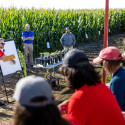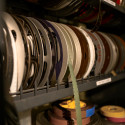Technique preserves sexual function for men with prostate cancer
Men diagnosed with localized prostate cancer have typically been faced with “good” news and “bad” news. The “good” news – if there is such a thing when cancer is involved – is that most men are effectively cured of their cancer once the prostate is surgically removed. The “bad” news is that the two most notable side effects of prostate surgery – impotence and incontinence – can be very devastating.
Fortunately, significant advances have been made on both fronts, and one UW Comprehensive Cancer Center urologist has been actively involved in new techniques to minimize both incontinence and impotence.
Of particular note is a surgical technique that, based on early results, has preserved sexual function for several men who would have been permanently impotent after conventional prostate surgery.
“With more than 220,000 new cases in the United States expected this year, prostate is the most common form of cancer among men. With so many men affected by this disease, one of the first questions men have before surgery is whether sexual function will be lost,” says David Jarrard, an associate professor of urology at the UW and head of the UW Comprehensive Cancer Center’s urologic oncology group.
“Most men we operate on are candidates for nerve-sparing surgery,” Jarrard says, referring to a technique that preserves sexual function by avoiding damage or removal of the cavernous nerves that make erections possible. “For some men, however, we have no choice but to remove the cavernous nerves because the cancer has spread to nearby tissue.”
It is for these men – especially younger men who had planned on many years of sexual function — that Jarrard has especially good news.
He is one of a handful of urologists nationwide that perform a state-of-the-art type of prostate cancer surgery known as sural nerve grafting. The technique, in which Jarrard partners with plastic surgeon Michael Bentz, professor and chair of the UW’s Division of Plastic and Reconstructive Surgery, involves removing a sural nerve segment from the man’s ankle and sewing the nerve into the groin. The sural nerve segment from the ankle replaces the cavernous nerve that had to be removed along with the prostate.
“Sural nerve grafting is essentially a nerve transplant,” Jarrard says. “We use the sural nerve alongside the ankle because it is a sensory nerve that is not going to be missed once it is removed from the leg. Although it takes about 12 to 18 months for the nerves to fully graft,” Jarrard says, “early results with our patients are very promising.”
Of Jarrard’s nine patients who have had sural nerve grafting, five are at least a year beyond surgery and all of these are able to have either unassisted or partial erections.
Pioneered just three years ago by Edward Kim, currently at the University of Tennessee, Knoxville, sural nerve grafting has shown similar promise in its initial clinical studies. Half of the 23 men who had sural nerve grafting performed by Kim and his research colleagues were able to have at least partial erections at least 12 months after surgery.
“The men we have operated on are very pleased,” Jarrard says. “In the past, you would typically take the prostate and both nerves and say ‘You’re going to be impotent,’ and that’s it. For men who are in their 40s, 50s, or 60s, it makes a big difference not having to say that anymore,” he says.
More information about sural nerve grafting is available by contacting the UW Comprehensive Cancer Center’s Cancer Connect service at (800) 622-8922 or (608) 262-5223. The e-mail address is uwccc@uwccc.wisc.edu. Additional information may be obtained at http://www.surgery.wisc.edu/urology/uwpgcp/.
The UW Comprehensive Cancer Center is one of 40 comprehensive cancer centers in the nation – and the only in Wisconsin – recognized for its excellence in research, patient care, education and community outreach by the National Cancer Institute, the lead federal agency for cancer research.
Tags: research




